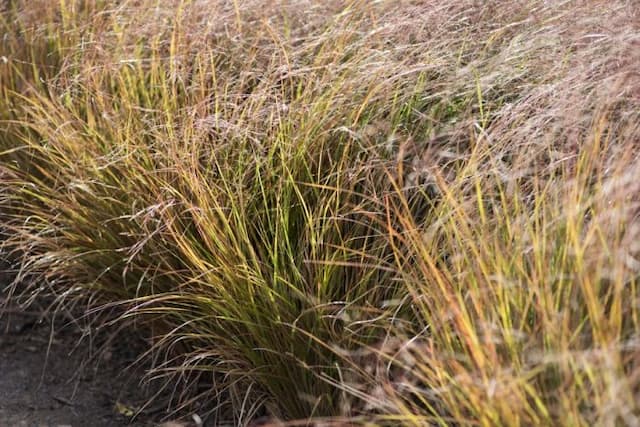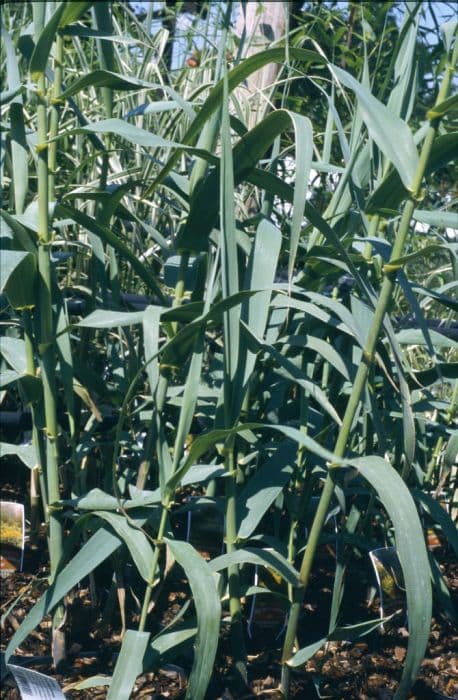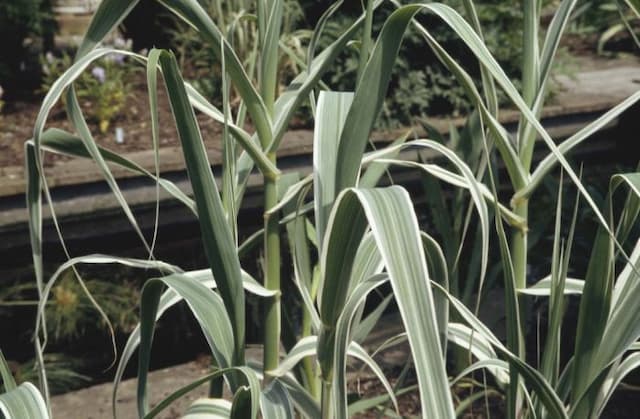Quaking grass Briza media 'Limouzi'











ABOUT
The plant known as Quaking Grass is characterized by its unique, delicate flowers and graceful foliage. The flowers of Quaking Grass display a distinct heart or lantern-like shape that gracefully dance and shimmer with even the gentlest breeze, creating a soft, rustling sound that adds an auditory charm to the plant's visual beauty. These flowers are usually borne in loose, open clusters at the tips of slender stalks, giving the plant a light and airy texture. The foliage of Quaking Grass is comprised of slender, green leaves that form a tufted base from which the flower stalks emerge. The leaves are typically long and narrow with a soft, hair-like quality, adding to the overall delicate nature of the Quaking Grass. The green color of the leaves may turn golden or bronze in the fall, providing seasonal interest in the garden. Overall, the pleasing combination of its dancing flowers and fine foliage make Quaking Grass a delightful addition to any garden space where movement and delicacy are desired.
About this plant
 Names
NamesFamily
Poaceae
Synonyms
Quaking Grass, Cow Quake, Doddering Dillies, Dithery Dock, Jiggle-joggles, Lady's Hair, Maidenhair Grass, Pearl Grass, Quakers, Quaking-grass, Rattlesnake Grass, Shaking Grass, Totter Grass, Wag-wantons
Common names
Briza media.
 Toxicity
ToxicityTo humans
Quaking grass is generally not considered toxic to humans. There is no significant evidence to suggest that Briza media 'Limouzi' or any common variants of quaking grass pose a threat if ingested. As with any non-food plant, it is always possible for individuals to have an allergic reaction or experience gastrointestinal discomfort if they consume parts of the plant, but standard quaking grass is not known for being poisonous.
To pets
Quaking grass is not typically known to be toxic to pets, either. Briza media 'Limouzi', as a cultivar of quaking grass, is also not regarded as having toxic properties that would harm pets if they were to ingest it. However, as with any plant, individual animals might have sensitivity or allergic reactions, or could experience mild stomach upset if they eat a significant amount of the grass. It's always best to keep an eye on pets and prevent them from eating large amounts of any non-food plants, including quaking grass.
 Characteristics
CharacteristicsLife cycle
Perennials
Foliage type
Deciduous
Color of leaves
Green
Flower color
Purple
Height
1-2 feet (30-60 cm)
Spread
1 foot (30 cm)
Plant type
Herb
Hardiness zones
4
Native area
Europe
Benefits
 General Benefits
General Benefits- Aesthetic Appeal: Briza media 'Limouzi', commonly known as Quaking Grass, has delicate, pendulous flower heads that add a unique texture and visual interest to gardens and landscapes.
- Low Maintenance: It is known for being easy to grow and requiring minimal care, making it ideal for gardeners of all skill levels.
- Drought Tolerance: Once established, Quaking Grass is relatively tolerant of dry conditions, reducing the need for frequent watering.
- Attracts Wildlife: The plant provides habitat and food for various insects, which in turn can attract birds and other wildlife to the garden.
- Seasonal Interest: It offers seasonal interest with its airy flower heads that are particularly attractive when backlit by the sun.
- Ornamental Seeds: The seeds of Quaking Grass can be used in dried floral arrangements, adding longevity to its ornamental value beyond the growing season.
- Versatile Planting: This grass is suitable for planting in a range of garden styles, including prairie planting, naturalistic landscapes, and traditional flower borders.
- Soil Stabilization: Its roots help stabilize the soil, preventing erosion in certain garden situations.
- Adaptable Growth: Quaking Grass can adapt to a variety of soil types, though it prefers well-drained soil.
 Medical Properties
Medical Properties- This plant is not used for medical purposes.
 Air-purifying Qualities
Air-purifying QualitiesThis plant is not specifically known for air purifying qualities.
 Other Uses
Other Uses- Quaking grass is often used in dried flower arrangements due to its unique shaking heads that add movement and texture to the display.
- In landscape design, Briza media 'Limouzi' can be planted en masse to create a meadow-like effect or used as a border plant for its whimsical appearance.
- The seeds of quaking grass are sometimes used in crafts, such as jewelry making, because of their interesting shape and aesthetic appeal.
- This grass can be included in a sensory garden as it has a tactile nature that responds to touch and wind, making it an interesting plant to experience.
- Briza media 'Limouzi' can be used in educational gardens to teach about the lifecycle of grasses and the structure of inflorescences.
- The gentle rustling sound of Briza media 'Limouzi' in the breeze can be used in gardens designed for sound therapy, providing calming and soothing auditory stimuli.
- Photographers sometimes use quaking grass as a subject or backdrop for close-up photography due to its delicate and intricate flowers.
- Quaking grass can be used in rituals or ceremonies as a symbol of humility and flexibility, akin to its movement in the wind.
- The plant can be included in habitat gardens, offering shelter for small insects and other invertebrates.
- Quaking grass can be incorporated into performance art or installations that explore concepts of movement and fragility in nature.
Interesting Facts
 Feng Shui
Feng ShuiThe plant commonly known as Quaking Grass is not used in Feng Shui practice.
 Zodiac Sign Compitability
Zodiac Sign CompitabilityQuaking Grass is not used in astrology practice.
 Plant Symbolism
Plant Symbolism- Peacefulness: Briza media, known as quaking grass, has delicate seed heads that trembly gently even in soft breezes, evoking a sense of calm and tranquillity.
- Flexibility: Due to its flexible stems that sway with the wind without breaking, quaking grass is often associated with adaptability and resilience.
- Grace: The elegant sway of its seed heads gives the quaking grass a gracefulness, symbolizing beauty and poise.
 Water
WaterThe Quaking Grass should be watered regularly but with moderation, as it does not tolerate overwatering well. During the growing season, ensure the soil is kept moist but not waterlogged, which may require watering roughly once every week with about 1 gallon of water, depending on the climate and soil drainage. Decrease the frequency of watering during the dormant season, making sure to allow the soil to dry out slightly between waterings.
 Light
LightQuaking Grass thrives best in full sun to partial shade. The ideal location for this grass would be a spot that receives direct sunlight for at least 6 hours a day, with some relief from the intense midday sun, which can sometimes be too harsh.
 Temperature
TemperatureQuaking Grass prefers temperate conditions and can survive in temperatures ranging from 40 to 80 degrees Fahrenheit. The ideal temperature range for the healthy growth of Quaking Grass is between 50 and 75 degrees Fahrenheit, avoiding the extremes of cold and hot weather.
 Pruning
PruningQuaking Grass generally requires little pruning. Remove dead or faded foliage in early spring to tidy up the plant and encourage new growth. The best time for any substantial pruning would be just before new growth begins in the spring.
 Cleaning
CleaningAs needed
 Soil
SoilQuaking grass thrives best in a well-drained soil mix with loamy or sandy texture, with a pH range of 6.0 to 7.0. Enrich the soil with compost or organic matter to ensure fertility and improve drainage. A standard potting mix amended with perlite and peat moss can also be suitable for container growing.
 Repotting
RepottingQuaking grass, being a hardy perennial, typically doesn't require frequent repotting. Repotting can be done every 2-3 years to refresh the soil or when the plant has outgrown its current container.
 Humidity & Misting
Humidity & MistingQuaking grass prefers moderate humidity levels but is quite adaptable to different humidity conditions typically found in most homes. It doesn't require a specific humidity range to thrive.
 Suitable locations
Suitable locationsIndoor
Place in bright, indirect light.
Outdoor
Full sun to part shade, moist soil.
Hardiness zone
4-9 USDA
 Life cycle
Life cycleBriza media 'Limouzi', commonly known as Quaking Grass, begins its life cycle as a seed, which germinates in early spring when soil temperatures are sufficiently warm. The seedling emerges and develops into a clump of slender, green foliage. As the plant matures, it sends up taller stems topped with delicate, heart-shaped florets that quiver or 'quake' in the wind, which typically occurs in late spring to early summer. After flowering, the plant undergoes pollination, where the flowers develop into seed heads and disperse seeds for the next generation. During the summer, the seeds ripen and the plant starts to become dormant, with the foliage dying back in the fall. Quaking Grass is a perennial plant, with its root system surviving through the winter, ready to begin a new growth cycle the following spring.
 Propogation
PropogationPropogation time
Spring to Early Summer
The Briza media 'Limouzi', commonly known as Quaking Grass, is best propagated by seed. The ideal time for sowing the seeds is in spring or autumn. To propagate by seed, first prepare a seedbed by loosening the soil and ensuring that it is free of weeds. Then, scatter the seeds evenly over the surface and lightly press them into the soil. It's not usually necessary to cover them with soil, but a light dusting can help prevent them from being eaten by birds or being blown away. Keep the soil moist until germination, which should occur within a couple of weeks if conditions are favorable. Once seedlings have established and are large enough to handle, they can be transplanted to their desired location in the garden.









